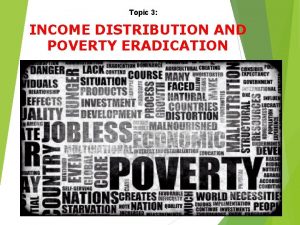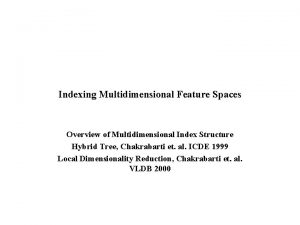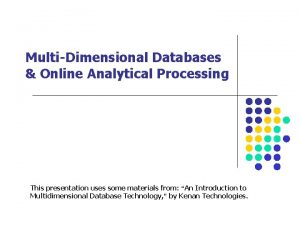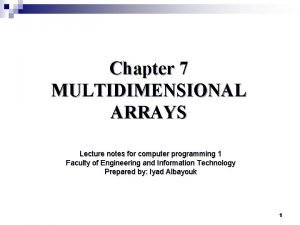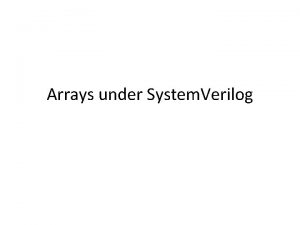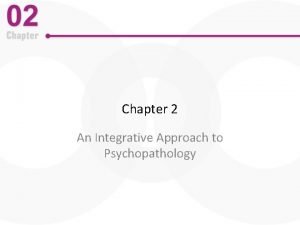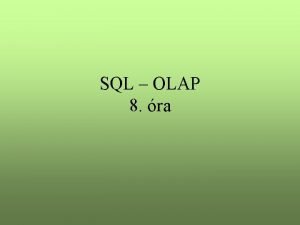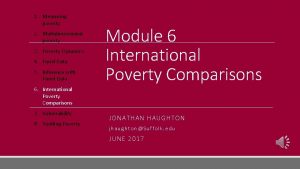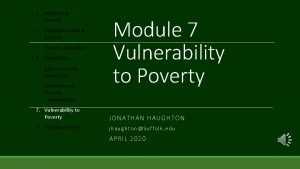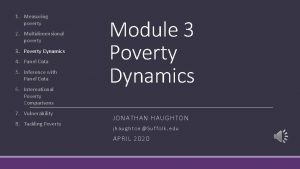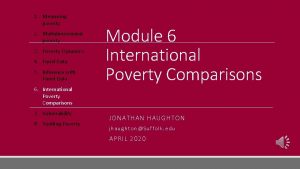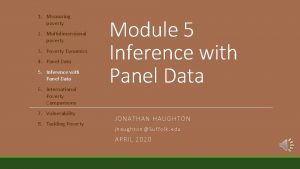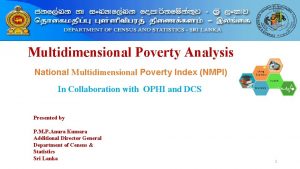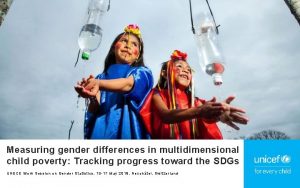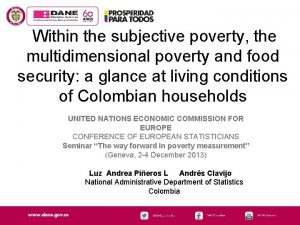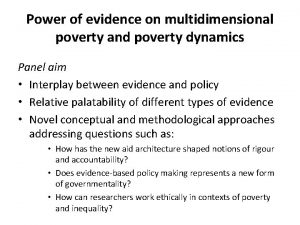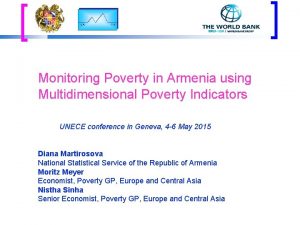1 Measuring poverty 2 Multidimensional poverty 3 Poverty











- Slides: 11

1. Measuring poverty 2. Multidimensional poverty 3. Poverty Dynamics 4. Panel Data 5. Inference with Panel Data 6. International Poverty Comparisons 7. Vulnerability 8. Tackling Poverty Module 4 Panel Data JONATHAN HAUGHTON jhaughton@Suffolk. edu APRIL 2020

Objectives 1. Examine the advantages of panel surveys 2. Explain how panel data can measure changes in poverty more precisely 3. Summarize the drawbacks of panel surveys, including attrition bias, decreased representativeness, and high managerial demands April 2020 JH: COURSE ON POVERTY MEASUREMENT 2

Types of panel data Households ◦ e. g. 1993 and 1998 Vietnam Living Standards Surveys Dwellings ◦ e. g. Peru Living Standards Survey: in 1990 returned to 1, 280 dwellings in Lima area Individuals ◦ e. g. U. S. Panel Survey on Income Dynamics (PSID), individuals surveyed regularly since 1968 April 2020 JH: COURSE ON POVERTY MEASUREMENT 3

Hybrids Constructed from repeated cross-sections ◦ e. g. Khandker et al. on districts in Thailand Rotating panels ◦ e. g. Cote d’Ivoire. ◦ 1985: 1600 hh. 1986: 800 of these + 800 others. April 2020 JH: COURSE ON POVERTY MEASUREMENT 4

Advantages of Panel Surveys Only way to measure transitions over time Less need for retrospective reporting Greater precision (see next slide) ◦ So smaller sample OK Can control for unobserved characteristics (see Module 5) Useful in impact evaluation April 2020 JH: COURSE ON POVERTY MEASUREMENT 5

Precision If independent samples: ◦ t-statistic = 0. 181, not significant ◦ t = 1. 348 if n=500 If paired ◦ t-statistic = 5. 393, change statistically v. significant Implication: Smaller samples OK April 2020 JH: COURSE ON POVERTY MEASUREMENT 6

Types of poverty (Rwanda example) Chronically poor need support Transiently non-chronically poor need insurance April 2020 JH: COURSE ON POVERTY MEASUREMENT 7

April 2020 JH: COURSE ON POVERTY MEASUREMENT 8

Targeting is hard April 2020 JH: COURSE ON POVERTY MEASUREMENT 9

Drawbacks of Panel Data Attrition bias ◦ e. g. Michigan PSID: 12 -15% dropped out after 1 st round, and 2. 4% p. a. dropped out after that. Loss of representativeness ◦ e. g. Over time, panel would age, leaving out newly-formed couples Defining the household: which to follow? ◦ e. g. year 0: husband + wife 1 + child 1 year 2: husband + wife 2 + child 2 // wife 1 + child 1 ◦ Rwanda follows all the “splits” – but they multiply! Cost ◦ Track households, needs good management April 2020 JH: COURSE ON POVERTY MEASUREMENT 10

Reading Haughton & Khandker, chapter 11 Jalan and Ravallion (1998) on targeting ◦ Jalan, Jyotsna, and Martin Ravallion. 1998. “Transient Poverty in Postreform Rural China. ” Journal of Comparative Economics 26: 338– 357. Khandker, Koolwal, Haughton & Jitsuchon (2012) on constructing a hybrid panel ◦ Khandker, Shahidur, Gayatri Koolwal, Jonathan Haughton, and Somchai Jitsuchon. 2012. Household Coping and Response to Government Stimulus in an Economic Crisis. Policy Research Working Paper, World Bank, Washington DC. April 2020 JH: COURSE ON POVERTY MEASUREMENT 11
 Difference between absolute and relative poverty
Difference between absolute and relative poverty Multidimensional or hypervolume niche
Multidimensional or hypervolume niche Multidimensional indexing
Multidimensional indexing What is a multidimensional database
What is a multidimensional database Escalamiento multidimensional no métrico
Escalamiento multidimensional no métrico Processing multidimensional array
Processing multidimensional array Systemverilog multidimensional array initialization
Systemverilog multidimensional array initialization Multidimensional approach to psychopathology
Multidimensional approach to psychopathology Multidimensional space in data mining
Multidimensional space in data mining Contoh program matriks array 2 dimensi python
Contoh program matriks array 2 dimensi python One-dimensional vs multidimensional models
One-dimensional vs multidimensional models Multidimensional expressions
Multidimensional expressions
